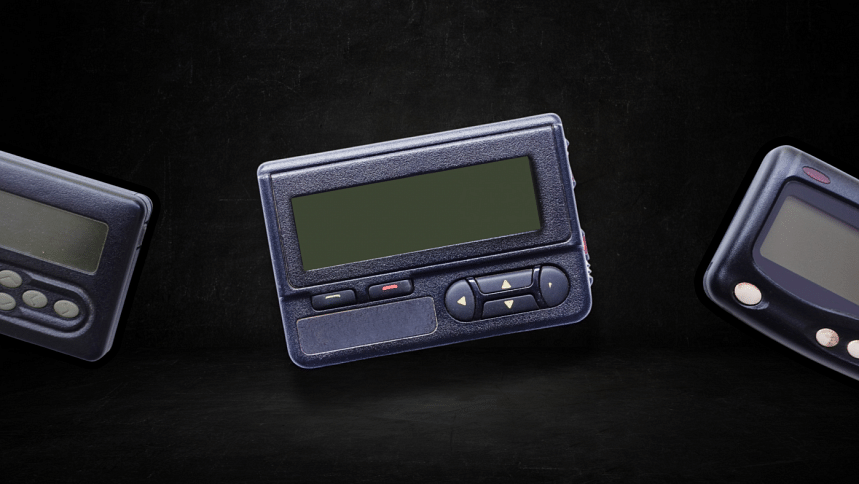Why have pagers become relevant?

Recently, pagers have reached the headlines around the globe as hundreds of pagers used by Hezbollah members exploded across Lebanon, killing at least nine people and wounding around 2,800 in blasts. There have also been sources claiming that Israel's Mossad spy agency planted explosives inside 5,000 pagers imported by the Lebanese group Hezbollah months before the recent detonations.
However, pagers aren't designed to be such destructive weapons - in fact, far from it. With an exploding pager trail running from Taiwan to Hungary, here are some key things you need to know about the popular communication devices known as pagers.
What are pagers?
Pagers, also known as beepers, are portable communication devices that are primarily used for receiving short messages or alerts. First introduced in the 1950s, pagers initially operated on a simple system that allowed the device to emit a beep or vibration to notify the user to call a specific number.
Over time, pagers evolved to support alphanumeric displays, allowing users to receive short text messages. Pagers operate on radio frequency networks, which are distinct from cellular networks. This makes them more reliable in certain scenarios, such as in hospitals or during emergencies, as they are less likely to experience network congestion or interference.
Although largely replaced by mobile phones and smartphones, pagers are still used in some industries today due to their simplicity, long battery life, and resilience against cybersecurity threats. Currently, pagers may seem like relics of a bygone era, overtaken by smartphones and instant messaging, but their impact on the evolution of modern communication technologies remains significant.
Evolution of pagers
The first commercial pager was developed by Motorola around the 1950s. The device could only alert the user through a beep or buzz, prompting them to contact a specific number for further instructions. It was a very basic system, yet essential in critical professions where instant notification could be a matter of life or death.
Pagers gained wider popularity in the 1980s and 1990s, as the technology advanced to allow alphanumeric messages, which eventually led to two-way communication. The ability to send and receive short text messages was revolutionary considering the era. By the mid-90s, pager use had exploded, particularly in the healthcare, business, and emergency response fields, where reliable communication was crucial.
Despite their dominance, pagers began to decline rapidly with the rise of mobile phones in the late 1990s and early 2000s. The introduction of mobile phones with text messaging capabilities, followed by the arrival of smartphones, rendered pagers obsolete for most consumers.
However, even as public use dwindled, pagers remained indispensable in niche industries like healthcare, emergency services, military, and high-security areas. In the medical field, for instance, pagers are still in use due to their reliability in dead zones where cellular data or WiFi might not work or have poor connectivity. Moreover, these devices are low maintenance, have long battery life, and are resilient against cybersecurity threats and network outages. As per the UK government, the country's National Health Service (NHS) was using around 130,000 pagers in 2017. This was more than one in 10 of the world's pagers with an annual cost of more than 6.6 million euros.

While their widespread consumer use has diminished, pagers have left a lasting legacy as their influence on messaging technology paved the way for the development of SMS, email, and mobile apps. The pager has become a symbol of how far technology has come.
Why does Hezbollah use pagers?
Hezbollah, the para militant and political organisation based in Lebanon, has long relied on low-tech solutions for communication to evade surveillance and tracking by adversaries, particularly Israel. In a world dominated by smartphones and advanced communication technologies, Hezbollah's preference for pagers seems to reflect a deliberate effort to avoid the vulnerabilities associated with more modern devices.
While modern mobile devices offer encrypted messaging and sophisticated communication options, they also create opportunities for adversaries to intercept messages or pinpoint users' locations. Pagers, on the other hand, operate in a more decentralised manner, transmitting over radio waves without needing internet connections or GPS signals. This makes them particularly valuable for groups concerned about electronic warfare and surveillance.
The organisation's reliance on pagers stems in part from a long history of Israeli intelligence successfully exploiting mobile phone vulnerabilities. An example of this occurred in 1996, when Yahya Ayyash, a bomb-maker for Hamas, was assassinated by Israel via a phone rigged with explosives.
In February, Hezbollah's leader, Hassan Nasrallah, made a public call during a live televised address, directing members of the group to abandon their mobile phones. According to a report by BBC, Nasrallah stated that the phones had been compromised by Israeli intelligence and instructed his forces to destroy, bury, or secure their devices in iron boxes to prevent further infiltration. This announcement signalled a shift towards more rudimentary, yet effective, methods of communication, likely involving the increased use of pagers.

 For all latest news, follow The Daily Star's Google News channel.
For all latest news, follow The Daily Star's Google News channel. 



Comments